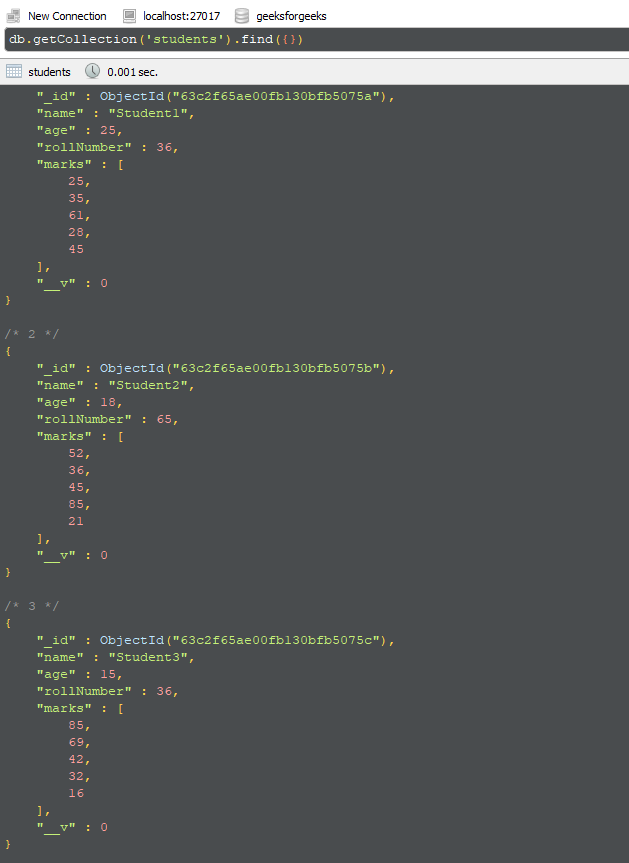Mongoose API 的 Mongoose Query API.prototype.elemMatch() 方法用於查詢對象。它允許我們匹配包含數組字段的文檔,並且該數組列表中的至少一個元素應與查詢表達式或過濾條件匹配。讓我們通過一個例子來理解elemMatch()方法。
用法:
query.elemMatch( path, filter );
參數:該方法接受兩個參數,如下所述:
- path:它用於指定集合中的路徑或字段名稱。
- filter: 用於指定過濾條件。它可以是對象或函數。
返回值:該方法返回查詢對象。
設置 Node.js Mongoose 模塊:
步驟 1:使用以下命令創建 Node.js 應用程序:
npm init
步驟 2:創建 NodeJS 應用程序後,使用以下命令安裝所需的模塊:
npm install mongoose
項目結構: 項目結構將如下所示:

數據庫結構:數據庫結構如下所示,以下數據庫存在於 MongoDB 中。

示例 1:下麵的示例說明了 Mongoose Connection 的基本函數elemMatch()方法。我們正在獲取其中任何元素的所有文檔分數數組大於 80。
文件名:app.js
Javascript
// Require mongoose module
const mongoose = require("mongoose");
// Set Up the Database connection
const URI = "mongodb://localhost:27017/geeksforgeeks";
const connectionObject = mongoose.createConnection(URI, {
useNewUrlParser: true,
useUnifiedTopology: true,
});
const studentSchema = new mongoose.Schema({
name: { type: String, required: true },
age: Number,
rollNumber: { type: Number, required: true },
marks: []
});
const StudentModel = connectionObject.model('Student', studentSchema);
const query = StudentModel.find()
query.where('marks');
query.elemMatch({ $gte: 80 })
query.exec((error, result) => {
if (error) {
console.log("Error -", error);
} else {
console.log("Result -", result);
}
})運行程序的步驟:要運行應用程序,請從項目的根目錄執行以下命令:
node app.js
輸出:
Result - [
{
_id: new ObjectId("63c2f65ae00fb130bfb5075b"),
name: 'Student2',
age: 18,
rollNumber: 65,
marks: [ 52, 36, 45, 85, 21 ],
__v: 0
},
{
_id: new ObjectId("63c2f65ae00fb130bfb5075c"),
name: 'Student3',
age: 15,
rollNumber: 36,
marks: [ 85, 69, 42, 32, 16 ],
__v: 0
}
]
示例 2:下麵的示例說明了 Mongoose Connection 的基本函數elemMatch()方法。我們正在獲取其中任何元素的所有文檔分數數組大於 20 且小於 50。
文件名:app.js
Javascript
// Require mongoose module
const mongoose = require("mongoose");
// Set Up the Database connection
const URI = "mongodb://localhost:27017/geeksforgeeks";
const connectionObject = mongoose.createConnection(URI, {
useNewUrlParser: true,
useUnifiedTopology: true,
});
const studentSchema = new mongoose.Schema({
name: { type: String, required: true },
age: Number,
rollNumber: { type: Number, required: true },
marks: []
});
const StudentModel = connectionObject.model('Student', studentSchema);
const query = StudentModel.find()
query.elemMatch('marks', { $gte: 20, $lte: 50 })
query.then(res => {
console.log(res);
}).catch(err => console.log(err));運行程序的步驟:要運行應用程序,請從項目的根目錄執行以下命令:
node app.js
輸出:
[
{
_id: new ObjectId("63c2f65ae00fb130bfb5075a"),
name: 'Student1',
age: 25,
rollNumber: 36,
marks: [ 25, 35, 61, 28, 45 ],
__v: 0
},
{
_id: new ObjectId("63c2f65ae00fb130bfb5075b"),
name: 'Student2',
age: 18,
rollNumber: 65,
marks: [ 52, 36, 45, 85, 21 ],
__v: 0
},
{
_id: new ObjectId("63c2f65ae00fb130bfb5075c"),
name: 'Student3',
age: 15,
rollNumber: 36,
marks: [ 85, 69, 42, 32, 16 ],
__v: 0
}
]
參考:https://mongoosejs.com/docs/api/query.html#query_Query-elemMatch
相關用法
- Mongoose Query.prototype.elemMatch()用法及代碼示例
- Mongoose Query.prototype.exec()用法及代碼示例
- Mongoose Query.prototype.explain()用法及代碼示例
- Mongoose Query.prototype.error()用法及代碼示例
- Mongoose Query.prototype.equals()用法及代碼示例
- Mongoose Query.prototype.estimatedDocumentCount()用法及代碼示例
- Mongoose Query.prototype.exists()用法及代碼示例
- Mongoose Query.prototype.all()用法及代碼示例
- Mongoose Query.prototype.and()用法及代碼示例
- Mongoose Query.prototype.batchSize()用法及代碼示例
- Mongoose Query.prototype.box()用法及代碼示例
- Mongoose Query.prototype.catch()用法及代碼示例
- Mongoose Query.prototype.centerSphere()用法及代碼示例
- Mongoose Query.prototype.circle()用法及代碼示例
- Mongoose Query.prototype.collation()用法及代碼示例
- Mongoose Query.prototype.cursor()用法及代碼示例
- Mongoose Query.prototype.distinct()用法及代碼示例
- Mongoose Query.prototype.geometry()用法及代碼示例
- Mongoose Query.prototype.getOptions()用法及代碼示例
- Mongoose Query.prototype.getPopulatedPaths()用法及代碼示例
- Mongoose Query.prototype.getUpdate()用法及代碼示例
- Mongoose Query.prototype.gt()用法及代碼示例
- Mongoose Query.prototype.gte()用法及代碼示例
- Mongoose Query.prototype.hint()用法及代碼示例
- Mongoose Query.prototype.lean()用法及代碼示例
注:本文由純淨天空篩選整理自sakshio0hoj大神的英文原創作品 Mongoose Query.prototype.elemMatch() API。非經特殊聲明,原始代碼版權歸原作者所有,本譯文未經允許或授權,請勿轉載或複製。
